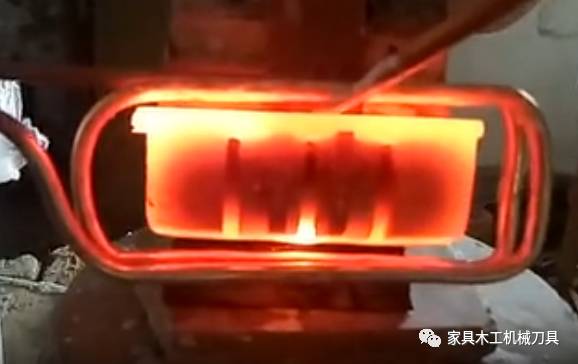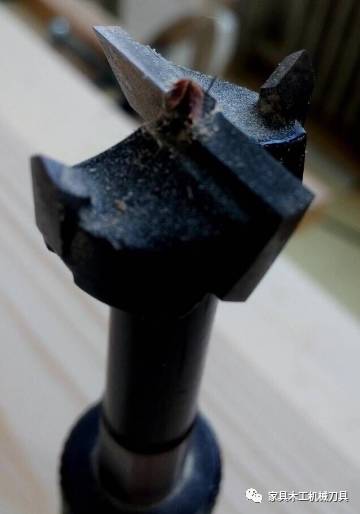Location:Home / News / Induction brazing of hard alloys and steel
Preparation work for woodworking cutting tools before welding
(1) Before welding, check the hard alloy for any defects. The welding surface must meet the technical requirements of the drawing, ensuring parallel gaps between the alloy and the substrate, in order to easily ensure welding quality.

(2) Sandblasting or polishing treatment should be carried out on the welding surface of hard alloy to remove the oxide layer and grease on the brazing surface, ensuring that the brazing material is easy to wet the hard alloy after liquefaction, and avoiding the occurrence of virtual welding or detachment.
(3) Before welding, check whether the welding surface on the steel substrate meets the technical requirements of the drawing. The steel substrate also needs to be sandblasted and cleaned to remove oil stains. Dry before welding.
(4) Cut the brazing material in advance and clean it with alcohol or gasoline; The shape of the brazing material with specific requirements should be similar to the welding surface.
(5) Practical experience has proven that if there is no high hardness requirement for the welding position of the steel substrate, the initial low hardness state of the welding area should be ensured or the local high-frequency annealing treatment should be carried out on the overall quenched blank, which can reduce the impact of quenching stress on the quality of the weld seam in the steel substrate; If there is quenching stress in the steel matrix, brazing heating can generate stress, which can easily lead to quality problems such as deformation, cracking of hard alloys, cracking of welds, and detachment of hard alloys.
Brazing process and process parameters
(1) Heating speed has a significant impact on welding quality.
(2) Practice has proven that the sequence of brazing operations and the position of brazing materials and fluxes have a direct impact on the quality of brazing. The appropriate sequence is: first sprinkle or apply brazing flux on the welding position of the steel substrate and hard alloy, then place brazing flux on the fixed steel substrate, and then place hard alloy.

(3) The cooling rate after welding is one of the main factors affecting brazing cracks. During cooling, instantaneous tensile stress is generated on the surface of hard alloy. As the tensile stress of hard alloy is much lower than the compressive stress, it is very important to control the cooling rate after welding. The usual practice is to immediately immerse the welded workpiece into lime powder or charcoal powder, allowing the workpiece to cool slowly. This method is easy to operate and has a certain effect of tempering to relieve stress, but it cannot control the tempering temperature and effect. The workpiece can be immediately placed into a tempering furnace after welding and tempered at 320-350 ℃ for 6 hours. Timely low-temperature tempering treatment can eliminate some brazing stress, reduce crack generation, and extend the service life of hard alloy tools.
Quality inspection and methods for brazing process
Weld seam gap (weld seam thickness) is an important parameter to ensure welding quality. If the weld layer is too thin, defects such as insufficient flow filling (incomplete brazing) may occur, resulting in a decrease in welding strength and an increase in welding stress; If the weld seam layer is too thick, the capillary effect will be weakened, and it will also lead to insufficient filling (incomplete brazing). Even if it is fully filled, the strength of the weld seam will decrease, which is very dependent on the strength of the brazing material itself. Therefore, a moderately sized weld layer thickness has a significant impact on reducing welding stress and enhancing weld fastness
The verification of feasible brazing processes generally only checks the quality of the weld between the hard alloy and the steel substrate of the welded blank, as well as the presence of cracks in the hard alloy itself. By observing the finished product or test piece of the blank with the naked eye or microscope, a normal weld should be uniform and free of black spots, pores, and cracks; Check if the thickness of the weld seam meets the design requirements. Whether the position of the hard alloy brazing blank meets the requirements
Popular products
News recommendations
Classification and common problems of shield tunneling tools2020-09-14
The cutting tools of shield tunneling machines can be classified according to their movement mode, arrangement position, method, and shape. According …
New type of aluminum alloy brazing material2020-09-14
The new brazing material and flux have a lower brazing temperature, which shortens the flow and filling time of the brazing material, lowers the brazi…
Brazing of aluminum and aluminum alloys2020-09-14
It should be pointed out that the process brazing performance of materials cannot be changed. With the development of brazing technology, new brazing …
Classification of brazing materials and flux2020-09-14
The main metal element in soft solder is tin, followed by lead, bismuth, zinc, gallium, antimony, cadmium, silver, copper, etc. The different combinat…
 If you have any questions or suggestions about the product, or if you want to know more, you can contact us at any time.
If you have any questions or suggestions about the product, or if you want to know more, you can contact us at any time.

Mobile website
Our Product
Contact Us